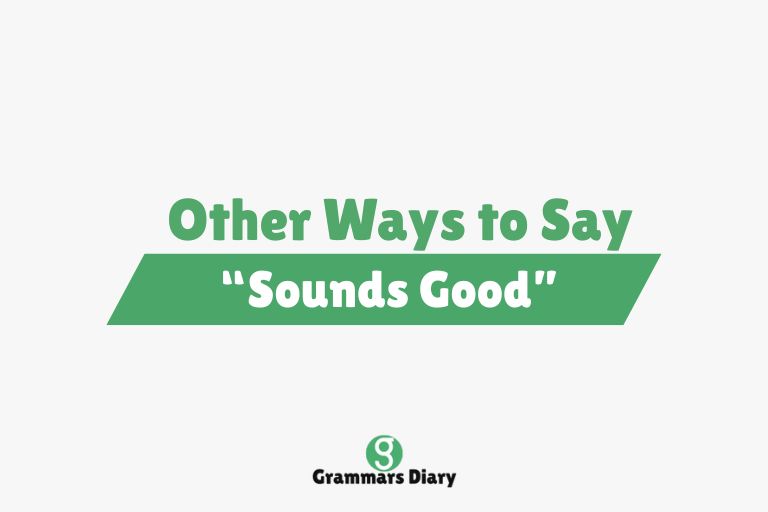The phrase “sounds good” is a casual yet frequently used expression that signals agreement, approval, or a positive response to a suggestion or plan. For instance, when someone says, “Let’s meet at 6 p.m.,” replying with “sounds good” conveys that the time works for you and that you’re on board with the arrangement.
However, while it is commonly used in daily conversations, overusing “sounds good” can make your responses feel repetitive or lacking in nuance. Fortunately, English offers many alternatives that allow you to communicate the same sentiment with variation and tone that can suit casual chats, professional discussions, or enthusiastic confirmations. This post dives into 18 alternatives to “sounds good,” providing examples, meanings, and context so that you can expand your vocabulary and communicate more effectively.
Other Ways to Say “Sounds Good”
1. That works for me
Example: “Let’s meet after lunch around 2?” — “That works for me.”
Meaning: This expression indicates that the proposed plan fits into your schedule or preferences without any issues.
Usage: Suitable for both casual and semi-formal settings, especially when agreeing to logistical arrangements or schedules.
2. Fine by me
Example: “We can have pizza tonight.” — “Fine by me.”
Meaning: A casual way of showing you have no objections and are okay with the suggestion or decision.
Usage: Often used in everyday conversations when expressing indifference or relaxed agreement.
3. I’m on board
Example: “We’re thinking of trying a new strategy next week.” — “I’m on board.”
Meaning: Shows enthusiastic agreement and a willingness to participate or support an idea or plan.
Usage: Common in both professional and informal contexts where group decisions or team involvement are required.
4. I’m good with that
Example: “Let’s reschedule our call to Monday.” — “I’m good with that.”
Meaning: A laid-back response indicating you are fine with the plan and have no concerns.
Usage: Perfect for digital communication, emails, or informal chats with friends and colleagues.
5. That’s acceptable
Example: “The meeting might be moved to 11 a.m. instead of 10.” — “That’s acceptable.”
Meaning: A polite or neutral way to convey that you agree or can tolerate the change or suggestion.
Usage: More formal than “fine by me,” often found in workplace conversations or written exchanges.
6. That’s fine
Example: “We’ll go with the original plan.” — “That’s fine.”
Meaning: A basic and neutral way to show approval or agreement, though tone can make it sound passive.
Usage: Universally used in all kinds of settings but may lack enthusiasm depending on delivery.
7. No problem
Example: “Can we push the deadline to Friday?” — “No problem.”
Meaning: Implies willingness and absence of conflict or issue with the suggestion.
Usage: Works well in casual and friendly settings, though tone and context should be considered to avoid sounding dismissive.
8. I’m okay with that
Example: “We might need to skip this week’s meeting.” — “I’m okay with that.”
Meaning: Shows passive acceptance and confirms that the suggestion is not troublesome for you.
Usage: Appropriate for casual or informal contexts when you’re expressing compliance without strong enthusiasm.
9. Works for me
Example: “Dinner at 8?” — “Works for me.”
Meaning: A modern, conversational phrase that confirms the suggestion is suitable or agreeable.
Usage: Very common in texts, casual chats, and even semi-formal business emails.
10. Sounds like a plan
Example: “We’ll meet at the café and walk over together.” — “Sounds like a plan.”
Meaning: Slightly more enthusiastic than “sounds good,” it implies agreement with an added sense of readiness.
Usage: Best suited for friendly interactions where a shared course of action is being confirmed.
11. All right
Example: “Let’s finalize this design tomorrow morning.” — “All right.”
Meaning: A simple, flexible expression that signals agreement, approval, or readiness to proceed.
Usage: Universally understood across all forms of conversation—casual, professional, or even instructional—depending on tone and context.
12. Sure thing
Example: “Could you send that report by this afternoon?” — “Sure thing.”
Meaning: A cheerful and friendly way of agreeing or confirming you’ll do something.
Usage: Most common in informal exchanges but also appropriate for friendly workplace interactions.
13. Absolutely
Example: “Do you mind if I bring a friend to dinner?” — “Absolutely.”
Meaning: An enthusiastic and wholehearted confirmation that goes beyond just agreeing.
Usage: Often used when you want to sound supportive, excited, or strongly affirming.
14. Agreed
Example: “Let’s move forward with the revised plan.” — “Agreed.”
Meaning: A direct and often formal way to state alignment with a proposal or decision.
Usage: Common in professional settings, particularly during meetings, emails, or planning discussions.
15. That’s agreeable
Example: “We’ll use the old structure but add new content.” — “That’s agreeable.”
Meaning: Polite and composed, this phrase communicates willingness to go along with a plan.
Usage: More common in written English or formal speech where politeness and clarity are emphasized.
16. Fair enough
Example: “We’ll need to adjust the budget slightly.” — “Fair enough.”
Meaning: Implies that the suggestion is understandable or reasonable, even if it’s not ideal.
Usage: Works well when acknowledging the practicality or necessity of an idea you can accept.
17. I’m in
Example: “We’re thinking of organizing a team lunch next Friday.” — “I’m in.”
Meaning: Informal, enthusiastic expression showing you’re ready and willing to participate.
Usage: Best used in casual group planning, social invites, or friendly collaboration scenarios.
18. Count me in
Example: “We’re going for a hike this weekend—want to join?” — “Count me in.”
Meaning: A warm, eager expression to say you’re interested and want to be included.
Usage: Perfect for informal invites, team activities, or expressing interest in group plans.
When to Use Different “Sounds Good” Alternatives
In Professional Settings
In a workplace or formal environment, you might prefer phrases like “Agreed,” “That’s acceptable,” or “Absolutely” to communicate agreement while maintaining a tone of professionalism. These expressions provide clarity and also help project a sense of confidence and readiness in communication, especially during meetings or planning discussions.
In Casual or Friendly Conversations
For everyday chats, social media interactions, or group planning with friends, responses such as “Sure thing,” “No problem,” “I’m in,” or “Sounds like a plan” are more natural and relatable. These expressions bring warmth and ease to the exchange, helping you sound approachable and cooperative.
In Texts or Digital Communication
In texting or emails, short and efficient responses like “Works for me,” “Fine by me,” or “All right” tend to work well. These options are straightforward yet polite and reflect a quick acknowledgment without the need for extra formality.
Conclusion
While “sounds good” is a reliable and commonly used phrase, incorporating a broader range of alternatives can help you sound more thoughtful, intentional, and context-appropriate in your communication. Whether you’re texting a friend, replying to a work email, or affirming a plan, selecting the right phrase enhances your clarity and shows attention to tone. Mastering these subtle shifts in language not only improves communication but also boosts your ability to express yourself with nuance.
FAQs
What does “sounds good” mean?
It’s an informal way to express agreement, approval, or confirmation that a suggestion or idea is acceptable to you.
Is “sounds good” professional?
While “sounds good” is widely used, it’s more informal. In professional settings, consider alternatives like “Agreed” or “That’s acceptable.”
Can I use “sure thing” in formal writing?
“Sure thing” is generally too casual for formal writing or business emails. Instead, use “Certainly” or “Absolutely” depending on tone.
Which alternatives are best for texting?
“Works for me,” “All right,” and “Fine by me” are short, easy-to-read options that work well in text messages or chat apps.
Is “I’m in” the same as “sounds good”?
“I’m in” expresses more enthusiasm and commitment to participate, while “sounds good” is more passive and may simply show agreement.











